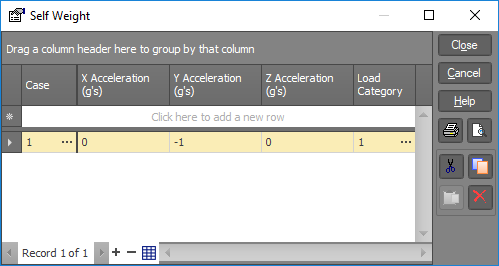Self weight data

Self weight loads are considered as forces and moments in a static analysis and as masses in a dynamic analysis.
Self weight can be automatically generated by the program if an acceleration (such as gravity) is specified. Acceleration may be specified along any of the three global axis directions. Note that self weight will only be considered if non-zero mass densities are specified in the material property data.
When self weight loads are used as masses in a dynamic analysis, the direction and magnitude of the X, Y and Z accelerations are ignored. The process simply involves calculating the mass of each member and then applying half of it as translational lumped masses to each of the member end nodes in each of the unrestrained X, Y and Z global axis directions.
Self weight may be applied in any load case and may be combined with other load types within the same load case.
Case
Load case to contain self weight.
X, Y and Z acceleration
Acceleration applied to the entire structure. See Units for the appropriate acceleration units that apply.
Load category
The load category column lets you specify which load categories the loads will go into. For more information refer to "Load categories".
See also Self weight text.
See also Datasheet Input.
See also Self weight.
See also Cable members.